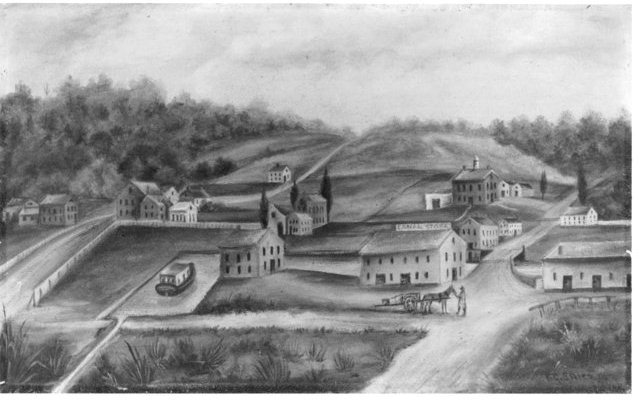Last updated: July 2, 2015
Lesson Plan
Historical Math and the Blackstone Canal

- Grade Level:
- Middle School: Sixth Grade through Eighth Grade
- Subject:
- Math,Social Studies
- Lesson Duration:
- 90 Minutes
- Common Core Standards:
- 6.RP.3, 7.RP.3
- State Standards:
- Massachusetts USII.2 Explain the important consequences of the Industrial Revolution. (H, E)
- Thinking Skills:
- Understanding: Understand the main idea of material heard, viewed, or read. Interpret or summarize the ideas in own words. Applying: Apply an abstract idea in a concrete situation to solve a problem or relate it to a prior experience. Analyzing: Break down a concept or idea into parts and show the relationships among the parts. Creating: Bring together parts (elements, compounds) of knowledge to form a whole and build relationships for NEW situations. Evaluating: Make informed judgements about the value of ideas or materials. Use standards and criteria to support opinions and views.
Objective
How can math be used to explore the impact of the Blackstone Canal on Worcester?
Background
The Blackstone Canal, a 45 mile waterway linking Worcester, Massachusetts to Providence, Rhode Island, was a powerful catalyst for economic change and growth, stimulating the "transportation revolution" which was at the center of Worcester's transformation from a landlocked agrarian outpost to a center of commercial activity. The arrival of the Blackstone Canal began a tradition of innovation and enterprise that continues to characterize Worcester industry.
This math lesson is one in a collection of lessons, designed to introduce students to the use of primary sources, tells the story of the canal and its impact on Worcester, Massachusetts. The Blackstone Canal, a 45 mile waterway linking Worcester, Massachusetts to Providence, Rhode Island, was a powerful catalyst for economic change and growth, stimulating the "transportation revolution" which was at the center of Worcester's transformation from a landlocked agrarian outpost to a center of commercial activity. The arrival of the Blackstone Canal began a tradition of innovation and enterprise that continues to characterize Worcester industry.
Preparation
*Decide whether math activities will be done in homogenous, heterogenous, or self-chosen pairs
*Make one copy per student of the Blackstone Canal Brochure, math activity worksheets and the press release assessment.
*Set up five stations with one math activity or challenge at each station.
*Optional: For each math challenge the students complete, give them a math stamp or sticker.
Materials
These five math activities or challenges investigate the Blackstone Canal using mathematical skills.
Download Historical Math Challenges
Use this brochure in the hook of the lesson to give background knowledge of the canal and prompt mathematical questioning.
Download Blackstone Canal Brochure
Lesson Hook/Preview
- Put students into pairs. Give each pair the Blackstone Canal Brochure. Ask the students to read the brochure and make a list of mathematical questions that could be asked about the Blackstone Canal. If students get stuck, give them a calculator and tell them to use the buttons to prompt their thinking.
- Ask the students to share their mathematical questions. Explain to students that they will be try to master five mathematical and historical challenges. If they have time, they can also answer their own questions.
Procedure
1. Divide the pairs into the five different math challenge stations evenly. Tell the students their goal is to master as many challenges accurately as possible within the next forty-five minutes. They will be using math to answer historical questions about Worcester and the Blackstone Canal.
2. Put 45 minutes on a clock and tell students to begin. As the students complete a challenge, they should raise their hand to get the challenge checked before they move on to the next.
3. At the end of the 45 minutes, ask the students to stop and return to their original seats. Ask the students what they learned about the Blackstone Canal and Worcester through their mathematical investigation. Ask the students what mathematical skills were important to their investigation.
4. Tell students that they will use their experience using math to investigate history to help the Massachusetts Department of Higher Education. They will work as a Public Relations Officer and argue for the study of math for history majors.
Vocabulary
- Canal - an artificial waterway constructed to allow the passage of boats or ships inland or to convey water for irrigation.
- Canal Boat - a long, narrow boat used on canals.
- Canal Lock - a device used for raising and lowering boats, ships and other watercraft between stretches of water of different levels on river and canals.
- Transportation - the action of moving someone or something.
Assessment Materials
Press Release - Dept of Higher EducationStudents will demonstrate their understanding of how math can be used to investigate history through writing a press release for the Department of Higher Education. This press release will argue for math training for history majors.
Press Release - Dept of Higher Ed
Supports for Struggling Learners
*Heterogenous pairs
*Helpful math hints can be taped to each challenge station that re-teach the skills
*Highlighted copies of the math challenges
*Use of calculator
Enrichment Activities
*Students can go back to their own mathematical questions and investigate those answers using internet access. Additionally, the students can use those answers and questions to create a sixth mathematical challenge for their peers to complete.
Additional Resources
Blackstone River Valley Heritage Site: https://www.nps.gov/blac/index.htm
The Canal District of Worcester: http://www.thecanaldistrict.com/history.html
Related Lessons or Education Materials
Time Traveling through Worcester: Map Exploration of the Blackstone Canal
Blackstone Canal History: Informational Text Skill Development
Reasons for the Blackstone Canal
